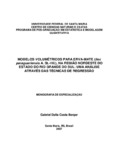| dc.contributor.advisor | Müller, Ivanor | |
| dc.creator | Berger, Gabriel Dalla Costa | |
| dc.date.accessioned | 2015-11-11T13:10:10Z | |
| dc.date.available | 2015-11-11T13:10:10Z | |
| dc.date.issued | 2007-12-17 | |
| dc.date.submitted | 2007 | |
| dc.identifier.uri | http://repositorio.ufsm.br/handle/1/1110 | |
| dc.description | Monografia (especialização) - Universidade Federal de Santa Maria, Centro de Ciências Naturais e Exatas, Curso de Especialização em Estatística e Modelagem Quantitativa, RS, 2007. | por |
| dc.description.abstract | This work aimed at the volumetric modeling for maté tea by the regression analysis,
selecting the model that best fit the data used, and determine the volume of each tight or
real tree by analytical method. Were evaluated thirty (30) trees. in each tree were
measured variables biometric total height in meters (ht), the diameter of the trunks 0.60
meters above the ground (d 0.6 meters), medium radius of crown in meters (rc), the
crown area in square metres (ac). For the construction of the equations to estimate the
volume of wood with no bark and bark used in the statistical package Analisys Statistical
System version 8. Stepwise was used the method of selection of independent variables,
which limited the maximum the inclusion of three variables in the equations selected,
and the R2 part of the independent variable over 1% to consider it significant. The test of
selection of equations was performed with and without intercept. The results presented
by the equations without intercept was higher than equations with intercept, and was
then despised these latest. The average height, diameter, radius of crown, the crown
area, volume and volume in shell shelled were respectively: 2.9650 m, 4.4696 cm,
1,1607 m, 4,1382 m2, 0,0139 m3, and 0.,0108 m3. The standard deviation for height,
diameter, radius of crown, the crown area, volume and volume in shell shelled were
respectively: 0,5600 m, 0,8997 cm, 0,2299 m, 1,5895 m2, 0,0075 m3, 0,0050 m3. The
minimum value for height, diameter, radius of crown, the crown area, volume and
volume in shell shelled were respectively: 2,0000 m, 2,9600 cm, 0,7502 m, 1,7789 m2,
0,0055 m3 , 0,0042 m3. The maximum value for the height, diameter, radius of crown,
the crown area, volume and volume in shell shelled were respectively: 4,5000 m, 6,1300
cm, 1,7600 m, 8,1433 m3, 0,0367 m3 , 0,0231 m3. The equation selected to estimate the volume with bark was: vcc = 0,01273 * ln (h). The equation selected to estimate the
volume without bark was: vsc = 0,00076 * hd. | eng |
| dc.language | por | por |
| dc.publisher | Universidade Federal de Santa Maria | por |
| dc.rights | Acesso Aberto | por |
| dc.subject | Erva-mate | por |
| dc.subject | Análise de regressão | por |
| dc.subject | Modelagem | por |
| dc.title | Modelos volumétricos para erva-mate (Ilex paraguariensis A. St.-Hil.), na região nordeste do estado do Rio Grande do Sul: uma análise através das técnicas de regressão | por |
| dc.title.alternative | Volumetric models for maté tea (Ilex paraguariensis A. St .- Hil.), northeast region in state of the Rio Grande do Sul: through an analysis of techniques for regression | eng |
| dc.type | Trabalho de Conclusão de Curso de Especialização | por |
| dc.degree.local | Santa Maria, RS, Brasil. | por |
| dc.degree.specialization | Estatística e Modelagem Quantitativa | por |
| dc.description.resumo | Este trabalho teve como objetivos a modelagem volumétrica para erva-mate através da
análise de regressão, selecionando o modelo que melhor se ajuste aos dados
utilizados; bem como determinar o volume rigoroso ou real de cada árvore pelo método
analítico. Foram avaliadas trinta (30) árvores. Em cada árvore foram medidas as variáveis
biométricas altura total em metros (ht), diâmetro dos troncos a 0,60 metros acima do solo
(d 0.6 metros), raio médio de copa em metros (rc), área de copa em metros quadrados
(ac). Para a construção das equações para estimar o volume de madeira com casca e
sem casca utilizou-se o pacote estatístico Statistical Analisys System versão 8. Foi
utilizado o método Stepwise de seleção de variáveis independentes, em que se limitou ao
máximo a inclusão de três variáveis nas equações selecionadas, e o R2 parcial da variável
independente superior a 1% para considerá-la significativa. O teste de seleção de
equações foi realizado com e sem intercepto. Os resultados apresentados pelas equações
sem intercepto foram superiores às equações com intercepto, tendo sido então
desprezado esses últimos. A média da altura, diâmetro, raio de copa, área de copa,
volume com casca e volume sem casca foram respectivamente: 2,9650 m, 4,4696 cm,
1,1607 m, 4,1382 m2, 0,0139 m3, e 0,0108 m3. O desvio padrão para a altura, diâmetro,
raio de copa, área de copa, volume com casca e volume sem casca foram
respectivamente: 0,5600 m, 0,8997 cm, 0,2299 m, 1,5895 m2 , 0,0075 m3, 0,0050 m3 .
O valor mínimo para a altura, diâmetro, raio de copa, área de copa, volume com casca
e volume sem casca foram respectivamente: 2,0000 m, 2,9600 cm, 0,7502 m, 1,7789
m2, 0,0055m3, 0, 0,0042 m3. O valor máximo para a altura, diâmetro, raio de copa, área
de copa, volume com casca e volume sem casca foram respectivamente: 4,5000 m,
6,1300 cm, 1,7600 m, 8,1433 m3, 0,0367m3, 0,0231m3. A equação selecionada para
estimar o volume com casca foi a seguinte: vcc = 0,01273*ln(h). A equação selecionada
para estimar o volume sem casca foi a seguinte: vsc = 0,00076*hd. | por |
| dc.publisher.unidade | Centro de Ciências Naturais e Exatas | por |


